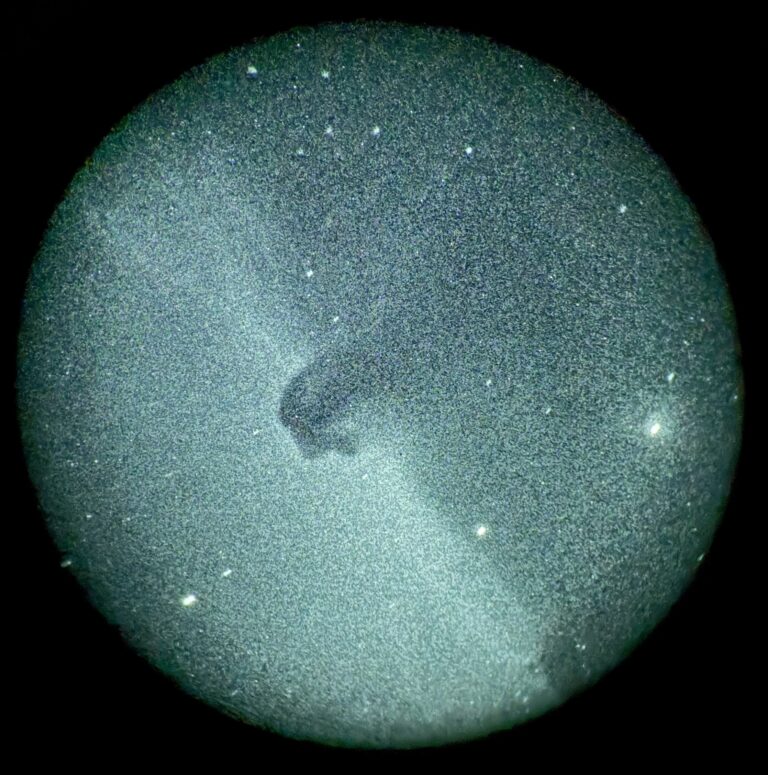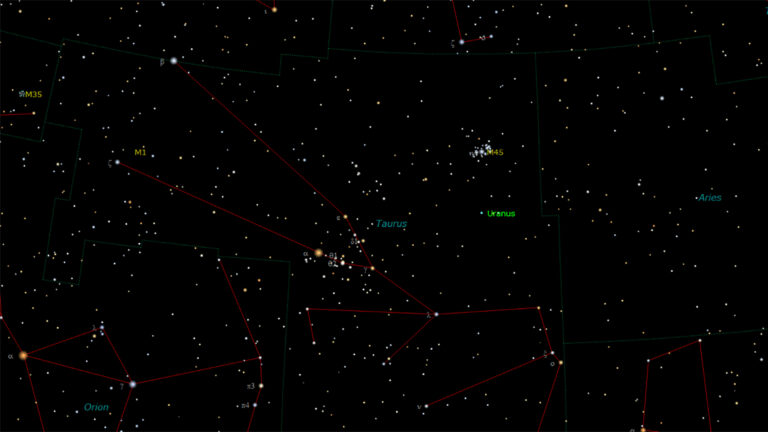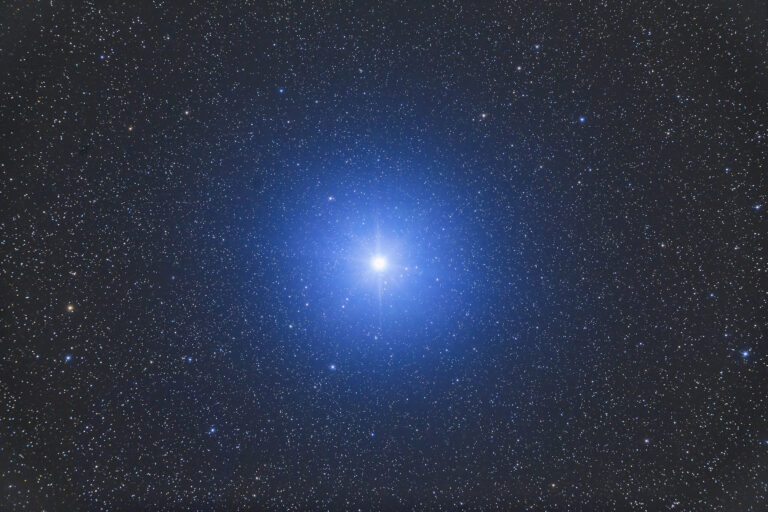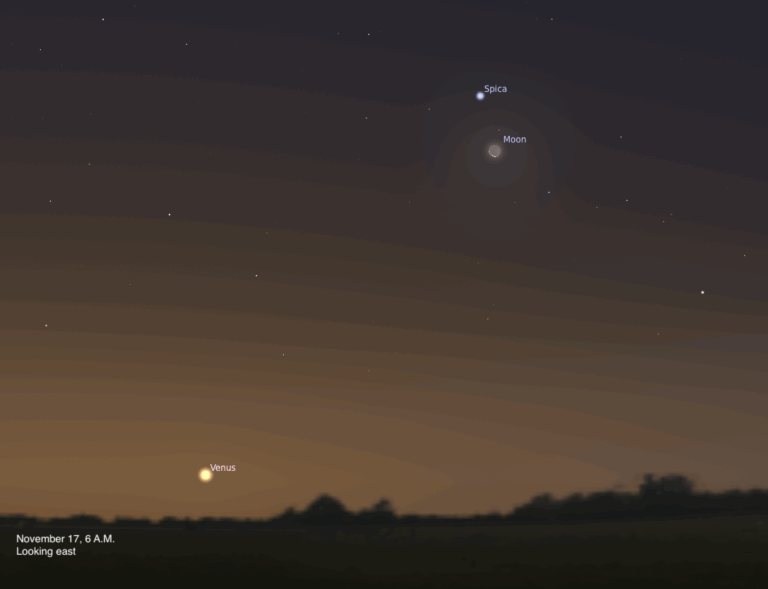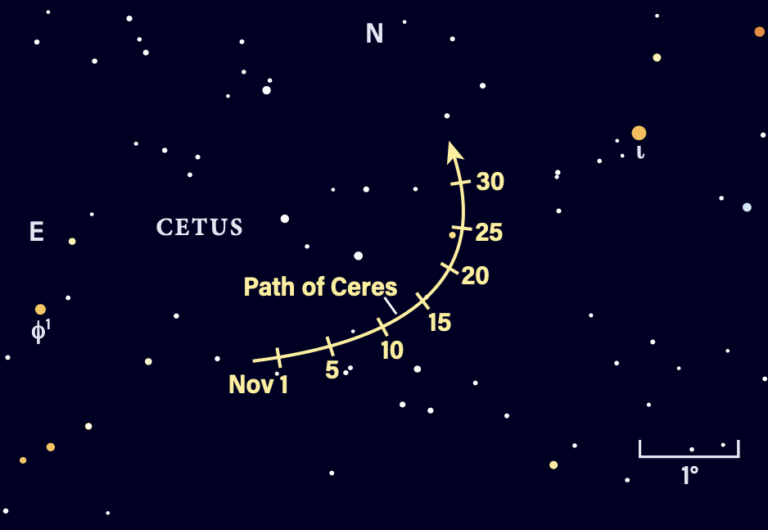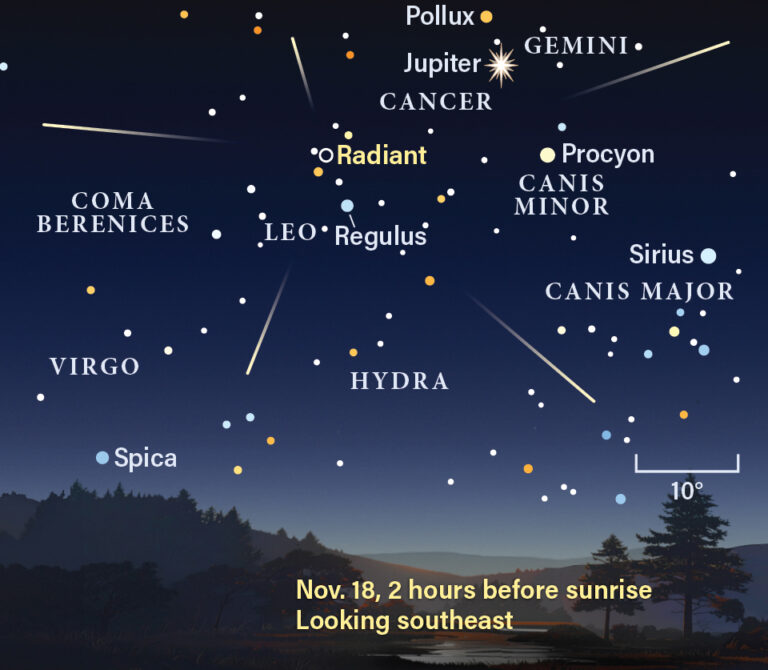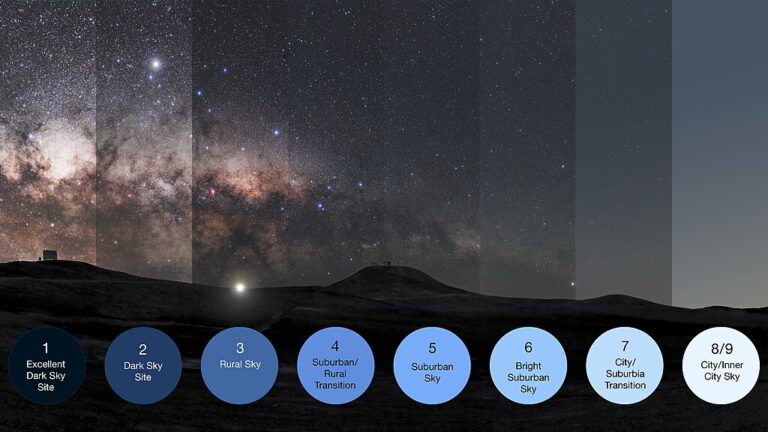Key Takeaways:
Friday, April 28
Mars continues to put on a nice show in late April. It appears nearly 15° high in the west-northwest an hour after sunset and doesn’t dip below the horizon until after 10 p.m. local daylight time. The magnitude 1.6 Red Planet appears against the backdrop of Taurus the Bull, between the Pleiades and Hyades star clusters. A waxing crescent Moon adds to the scene this evening. It stands 4° to the upper left of the 1st-magnitude star Aldebaran while Mars and the two star clusters reside a bit farther to the lower right.
Saturday, April 29
Venus appears brilliant in the eastern sky from the time it rises around 4:30 a.m. local daylight time until close to sunrise 90 minutes later. It stands about 10° above the horizon 45 minutes before the Sun comes up. Shining at magnitude –4.7, it appears slightly brighter today than at any other time during this morning apparition. (The difference is essentially imperceptible, however — it appears only a thousandth of a magnitude brighter today than it did yesterday or will tomorrow.) When viewed through a telescope this morning, Venus spans 39″ and appears one-quarter lit.
Sunday, April 30
This is a good evening to hunt down asteroid 29 Amphitrite through a telescope. The 10th-magnitude space rock lies in the constellation Leo, just 0.3° due west of magnitude 3.8 Rho (r) Leonis. The Lion appears about two-thirds of the way from the southern horizon to the zenith as twilight fades to darkness.
Monday, May 1
This week provides skywatchers with their final opportunity to get a good view of Sirius, the night sky’s brightest star, before evening twilight swallows it. This luminary gleams at magnitude –1.5 low in the southwestern sky. If you look an hour after sunset (approximately 9 p.m. local daylight time), Sirius lies about 10° high. In all likelihood, the star will be twinkling madly as its light passes through the thick layers of turbulent air that lurk near the horizon.
Tuesday, May 2
The First Quarter Moon hangs high in the southwest as darkness falls, then sinks steadily toward the western horizon throughout the evening hours. Our satellite officially reaches First Quarter phase at 10:47 p.m. EDT among the background stars of Cancer the Crab. It will remain on view until it dips below the horizon after 2 a.m. local daylight time tomorrow morning.
Wednesday, May 3
The Big Dipper’s familiar shape lies nearly overhead on May evenings. The spring sky’s finest binocular double star marks the bend in the Dipper’s handle. Mizar shines at 2nd magnitude, some six times brighter than its 4th-magnitude companion, Alcor. Even though these two are not physically related, they make a fine sight through binoculars. (People with good eyesight often can split the pair without optical aid.) A small telescope reveals Mizar itself as double — and these components do orbit each other.
Thursday, May 4
For those who like to observe during the quiet predawn hours, Saturn offers a visual treat this week. The ringed planet rises shortly before midnight local daylight time and climbs some 30° high in the south by the time morning twilight begins. It shines at magnitude 0.2 against the backdrop of northwestern Sagittarius. Take a look at Saturn through binoculars and you’ll also see the open star clusters M21 and M23 as well as the spectacular Lagoon (M8) and Trifid (M20) nebulae about 4° to the east. When viewed through a telescope, the planet shows an 18″-diameter disk surrounded by a stunning ring system that spans 41″ and tilts 26° to our line of sight.
Friday, May 5
Although the calendar says May, the sky’s Summer Triangle returns to prominence this month. The asterism’s three bright stars — Vega in Lyra, Deneb in Cygnus, and Altair in Aquila — all clear the horizon by midnight local daylight time. An hour later, they rule the eastern sky. Vega shines brightest and appears at the apex of the triangular asterism. Look for Deneb to Vega’s lower left and Altair to the lower right of the other two. The Summer Triangle will grace the Northern Hemisphere’s evening sky from now through the end of the year.
Saturday, May 6
The Eta Aquariid meteor shower reaches its peak before dawn. Although this is typically one of the year’s most prolific showers, a waxing gibbous Moon interferes with the 2017 show. The Moon sets around 4 a.m. local daylight time, just before morning twilight starts to paint the sky. For the best views, head outside an hour or two before then and find a spot where trees or buildings block the Moon’s glow low in the west. Eta Aquariid meteors derive from bits of debris ejected by Comet 1P/Halley during its many trips around the Sun. When Earth crosses this debris stream, our planet’s atmosphere incinerates the tiny dust particles and we see the streaks of light called meteors, or “shooting stars.”
Sunday, May 7
Although Jupiter reached opposition and peak visibility exactly one month ago, it remains a stunning sight nearly all night. It appears about 40° above the southeastern horizon an hour after sunset and climbs highest in the south around 11 p.m. local daylight time. As a bonus this evening, a waxing gibbous Moon appears just a few degrees away. The pair lies among the background stars of Leo, though only 1st-magnitude Spica some 10° below appears conspicuous thanks to the bright Moon nearby. When viewed through a telescope, Jupiter’s disk spans 43″ and shows a wealth of detail in its atmosphere.
Mars passes 6° due north (to the upper right) of Aldebaran today. Use binoculars to pick them out of the evening twilight. Although Aldebaran shines a half-magnitude brighter than the planet, Mars’ greater altitude should make it just as easy to see.




